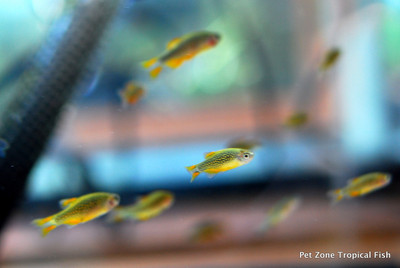Galaxy Rasbora
Posted by Max Gandara on on 13th Apr 2025
Galaxy Rasbora: A Jewel of the Aquarium World
The world of aquarium fish is home to a myriad of colorful and fascinating species, each with its own unique charm. Among these aquatic treasures, the Galaxy Rasbora, also known as the Celestial Pearl Danio (Danio margaritatus), stands out as a particularly captivating addition to any home aquarium. This blog will delve into the beauty, care, and fascinating traits of the Galaxy Rasbora, a true jewel of the aquarium world.
A Brief Introduction to the Galaxy Rasbora
The Galaxy Rasbora was first discovered in 2006 in Myanmar and has since become a beloved species among aquarists. Its small size, vibrant colors, and peaceful nature make it an ideal choice for both novice and experienced fish keepers. With an average size of about 1 inch (2.5 cm), it is perfect for small aquariums and community tanks.
Striking Appearance
One of the most alluring features of the Galaxy Rasbora is its stunning appearance. The fish boasts a deep blue body adorned with iridescent spots that resemble a starlit sky, hence its celestial name. The fins of the Galaxy Rasbora are equally striking, with bright red or orange hues that add to its overall beauty. This remarkable coloration makes them a standout species in any aquarium setup.
Ideal Tank Conditions
To ensure the health and happiness of your Galaxy Rasboras, it is essential to replicate their natural habitat as closely as possible. Here are some key considerations for their tank environment:
-
Tank Size: A minimum tank size of 10 gallons is recommended, although larger tanks are preferable to allow for schooling behavior.
-
Water Parameters: Maintain a temperature range of 73-79°F (23-26°C), a pH of 6.5-7.5, and soft to moderately hard water.
-
Decorations: Include plenty of plants, driftwood, and hiding spots to mimic their natural environment and provide security.
-
Lighting: Moderate lighting will enhance their colors without causing stress.
Diet and Feeding
Galaxy Rasboras are omnivorous and require a balanced diet to thrive. In the wild, they feed on small invertebrates and plant matter. In captivity, a varied diet is key:
-
Flake and Pellet Food: High-quality flake and micro-pellet foods should form the staple of their diet.
-
Live and Frozen Foods: Supplement their diet with live or frozen foods like brine shrimp, daphnia, and bloodworms for added nutrition.
-
Feeding Frequency: Feed them small amounts 2-3 times daily, ensuring they consume all food within a few minutes.
Compatibility and Behavior
Galaxy Rasboras are peaceful and social fish that thrive in groups. Keeping them in schools of at least six will encourage natural behavior and reduce stress. They are compatible with other small, non-aggressive species, making them an excellent choice for community tanks. Suitable tank mates include:
-
Other Small Rasboras: Such as Harlequin Rasboras or Chili Rasboras.
-
Small Tetras: Like Neon Tetras or Ember Tetras.
-
Peaceful Bottom Dwellers: Such as Corydoras or small loaches.
Breeding the Galaxy Rasbora
Breeding Galaxy Rasboras in captivity can be a rewarding endeavor. To encourage breeding, increase feeding frequency and provide a slightly warmer environment. These fish are egg scatterers, laying their eggs among plants and substrate. Once the eggs are laid, it is essential to remove the adults to prevent them from eating the eggs. After about 2-3 days, the eggs will hatch, and the fry can be fed with infusoria or finely crushed flake food.
Conclusion
The Galaxy Rasbora is a spectacular addition to any aquarium, offering both beauty and tranquility. With proper care, these shimmering fish can bring years of joy and fascination to aquarists. Whether you're a beginner looking to start your aquatic journey or an experienced hobbyist seeking to add a splash of color to your tank, the Galaxy Rasbora is an excellent choice. Enjoy the celestial beauty of these aquatic gems as they glide gracefully through their watery home.

